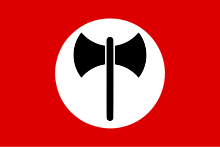
Back Nazimaoísmo Spanish Nazi-maoïsme French Nazi-maoismo Italian Nazimaoismo Portuguese Наци-маоизм Russian 纳粹毛主义 Chinese

Nazi-Maoism was a political movement and ideology that emerged in Italy around 1968,[1] with the formation of a group known as Struggle of the People. This group of students, from the Sapienza University of Rome,[2] took heavy inspiration from the writings and theory of Franco Freda,[3] and advocated for a combination of ideas from both the far-left and far-right. According to the neo-fascist group Terza Posizione, Nazi-Maoism had a stance of "neither capitalism nor communism, neither reds nor reactionary".[4] Nazi-Maoists such as Freda wanted to form a "Fascist dictatorship of the proletariat",[5] by using the Maoist guerrilla strategy of people's war to overthrow the government and the bourgeoisie.[6]
Nazi-Maoism is believed to have mostly faded away after the Struggle of the People group dissolved in 1973. Some forms of Nazi-Maoism continued in other similar groups into the late 1970s, albeit not as active as the Struggle of the People. Some slogans can be found in numerous groups of the extra-parliamentary right, such as Terza Posizione and Forza Nuova. Despite an accentuated anti-communism and nationalist positions typical of the far-right, they have a strong attention to social problems, as well as a violent anti-Americanism and anti-Zionism.[7][8][9]
- ^ Sheehan, T., 1981. "Italy: Terror on the Right". The New York Review of Books, 27(21), pp.23–26.
- ^ Bessarione, Giuseppe Bessarione, 1979. Lambro / Hobbit. Right-wing youth culture. In Italy and Europe, Rome, Arcana Editrice, 1979, pp. 99–100
- ^ Andreoli, M., 1979. "Perspicacity of Nazi-Maoism Case of Freda, Franco and Massacre at Piazza-Fontana Effects On Italian Right". Ponte-Rivista mensile di politica e letteratura, 35(4), pp. 384–386.
- ^ Hoffman, B., 1989. The contrasting ethical foundations of terrorism in the 1980s. Terrorism and Political Violence, 1(3), pp.361–377.
- ^ Griffin, Roger, 2003. "From Slime Mould to Rhizome: An Introduction to the Groupuscular Right". Patterns of Prejudice, 37(1), pp.27–50.
- ^ Lebourg, N., 2015. "Arriba Eurasia? The Difficult Establishment of Neo-Eurasianism in Spain". Eurasianism and European Far Right: Reshaping the Europe-Russia Relationship.
- ^ Rossi, Gianni, 2003. La destra e gli ebrei: una storia italiana, Soveria Mannelli, Rubbettino Editore.
- ^ La strage di Stato, Rome: Samonà e Savelli, 1970.
- ^ Bessarione, Giuseppe, 1979. Lambro/Hobbit. La cultura giovanile di destra. In Italia e in Europa, Rome: Arcana Editrice, 1979, pp. 99–100